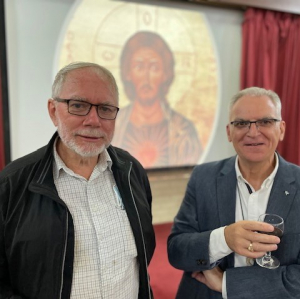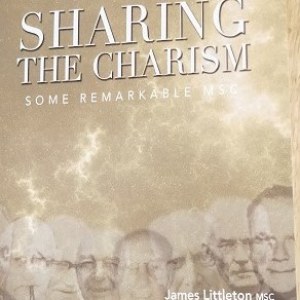Peter MALONE
Hatching
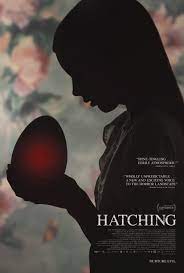
Finland, the 2022, 86 minutes, Colour.
Siiri Solalinna, Sophia Heikkila, Jani Volanen, Reino Nordin, Oica Olila, Ida Maattenen.
Directed by Hanna Bergholm.
A domestic horror film from Finland. However, in the opening moments, the director is trying to lure us into believing that the family - ultra-glamorous mother, bespectacled and silent father, bespectacled and silent little son, charming gymnast daughter, is the most wonderful and ideal family. Mother has a blog, continually filming, getting everyone to smile beyond belief, posting her film clips, talking to her seemingly adoring followers…
Then a little blackbird gets into the house, disrupting the photo-shoot, and smashing around, vases and glasses, even the chandelier. Everybody tries to catch the bird, the gymnast, Tinje, eventually throwing a blanket over the bird to save it. But, her mother wants it – and breaks its neck. Tranquility shattered!
However, this is Tinje’s story, Siiri Silalinna in her only films so far. We see her at gymnastic training, urged on by her photographing mother (and when we see her leg scar we realise that she is compensating). Tinge is good but certainly needs more work. However, more complications arise, guiding us into this story, wondering about the hatching.
That is soon explained because Tinje discovers the bird is not dead, and she puts it out of its misery – but then finds its egg which she secretly takes into the house, warming it in her bedroom, watching it grow, gigantic until a monstrous caricature of a bird emerges. Tinje is somewhat bewildered, fosters the bird until it kills the neighbour’s dog. Tinje is even more bewildered by her mother, carrying on an affair with the workman who comes to fix the chandelier, the mother with sweet words, gifts, favouritism, grooming her daughter to accept the relationship, even taking her to the house, where Tinje discovers that the workman, a widower, has a little baby which her mother absolutely dotes on.
Meanwhile, the mysterious bird whom Tinje names after a song she and her mother sing, Alii, begins to transform into the alter ego of Tinje. There are all kinds of drastic repercussions as we might expect.
This is a successful horror film for those who prefer their horror more moderate, more suggested than gory and graphic (although, of course, there are some moments).
Running under an hour and a half, much of the action in sunlight, a fine performance from the young girl who may have career ahead of her in films, an increasingly loathsome glamorous mother, and, of course, an ambiguous ending which leads us to make of it what we will.
- The title, the literal hatching, the enlarging of the egg, the birth of the monstrous bird? Tinje and her mothering of the egg?
- The Finland setting, the town, the comfortable home, the countryside, the mansion in the country, school, gymnastics? The musical score?
- The portrait of the family, affluent, the nice family, the mother and her continued filming, her blog, the portrait of the family, altogether, in their activities, her commentary? Her filming, speaking to the followers?
- The niceness, the intrusion of the bird, the flight in the house, breaking the vases and glasses, the chandelier, Tinje and her putting the blanket over the bird? The mother breaking its neck? Getting Tinje to bury it, going back later, the bird disappeared? Finding the bird, trying to help, the mercy-killing? The consequences? Finding the egg?
- The emerging tensions in the family? Tinje discovering her mother with Tero fixing the chandelier, her mother and grooming her daughter to accept the relationship, the smooth talk, the gifts, persuasion, and emotional dependence? The little boy, the image of his father, build and glasses? Antagonism towards his sister? The father, nice, the guitar, the not communicating well?
- The gymnastics, Tinje and her skills, but not quite? The sympathetic encouragement of the coach? Her mother ever-present, filming, the demands? Tinje and her trying, but her failures?
- The family moving next door, two girls, the dog, the death of the dog, burying it, the little brother bringing it inside? Tinje and her helping the girl with the notices about the lost dog? Their doing gymnastics together, a certain rivalry, but neither pushing the rivalry?
- The hatching of the monstrous bird, its appearance, its effect on Tinje? Its savagery, the dog, the gradual transformation into an image of Tinje? An alter ego? The bond between the two? Sister images? The breaking off of the beak, the hair, the dress, the transformation? Menacing, Tinje driving home with her mother, wanting to turn back, the girl on the street, the attack, the visit to the hospital, her injuries?
- The mother, glamorous, make up, looking in the mirror, filming, speaking to her followers? At the gym, the insistence, her own injury and failure in the past? The relationship with Tero, her attitude towards her husband, her son, being away, her husband believing her? Taking Tinje to the house, the discovery of the little baby? The mother and her mothering it?
- Tero, more sympathetic than expected, his daughter, helping Tinje, the confrontation with the monster, his hand and the injury? With the gymnastics, the baby left at home, under threat from the monster, Tero and his protection?
- Tinje, the telepathic linking with the monster, the threatened baby, Tinje falling and injuring herself? Her mother’s reaction? At home, the filming, talk about failure? Tinje overhearing?
- The monster, transformed, the two girls, the father and the brother and their discovery? The attack on the mother, the monster killing Tinje? The close-up of the monster, the close-ups of the mother – acceptance? The future?
Tous S'est Bien Passe/ Everything Went Fine
TOUS S’EST BIEN PASSE/ EVERYTHING WENT FINE
France, 2021, 113 minutes, Colour.
Sophie Marceau, Andre Dussolier, Geraldine Pailhas, Charlotte Rampling, Eric Caravaca, Hanna Schygulla, Gregory Gadebois.
Directed by François Ozon.
 A film which explores themes of ageing, illness, issues of assisted suicide. Well worth seeing and reflecting on. It has been written and directed by François Ozon, who has been making significant films for a quarter of a century.
A film which explores themes of ageing, illness, issues of assisted suicide. Well worth seeing and reflecting on. It has been written and directed by François Ozon, who has been making significant films for a quarter of a century.
(But, a criticism, not of the film itself, but on the Americanised translation of its title. The French says that everything went well. Now the adjective fine is used, American-wise, as an adverb, a rather off-putting colloquialisiing of language.)
Towards the end of the film, the old man, Andre Bernheim (with actor, Andre Dussolier, perfectly embodying an 85-year-old, the effect of strokes, hospitalisation, cantankerous disposition, demanding on his daughters) remarks that his story could be the subject of one of his daughter’s novels. In fact, this is the case. The film is based on a novel by Emmanuele Bernheim, played by Sophie Marceau with a blend of compassion and exasperation. And, the names of the central characters, of the whole family, are their real names.
Emmanuele is a novelist, middle-aged, living with cinema entrepreneur, Serge, close to her sister, Pascal (Geraldine Pailhas) and her children. Their mother, Claude, Charlotte Rampling, is a sculptress, ageing, years suffering from depression. Their parents have long separated – this theme revealed rather later in the film and highlighting quite some complexities.
Ordinary life is suddenly interrupted when Andre has a series of strokes, hospitalised, under care. He is not an exemplary patient, not even a good patient. While the illness takes its toll, he begins to recover, even able to participate in some past activities, a meal out, his grandson’s recital. But, the effect on his mind is a realisation that he does not want to live. He demands assisted dying.
This means that the audience has to check its own attitude towards assisted dying, assisted suicide, legislation in particular countries, here France, where hospital authorities have to take care, where police can intervene. Switzerland offers opportunities for assisted dying. There is something of a jolting sequence where Emmanuele asks the cost and is told that it is $10,000, plus ambulance transport – and wonders how people can afford this, her father nonchalantly noting that they have to wait till death comes.
While the family has a Jewish background, religious ethics are not part of the consideration. Rather, the focus is on a general outlook on living rather than dying, on some kind of palliative consideration, of encouraging life-giving activities. This does provide some moral dilemmas for the two daughters.
The screenplay goes into some detail about associations for assisted dying, a character, a lady from Switzerland (German veteran Hanna Schygulla) visits Paris, visits Andre, discusses with Emmanuelle, Andre having to talk onto phone camera declaring his wish to die, arranges for Andre to come to Bern.
There are some moments of humour in the story. There are many moments of pathos. There are complications with the attitude of Claude and the memories of her marriage. There are complications with an intrusive friend from the past and the audience discovering the sexual orientation of Andre.
So, this is a presentation of an actual case, raising the issue of assisted dying in the context of a secular perspective on life and death, in the context of restrictive legislation and practice, in the context of availability for assisted dying in Switzerland, offering the audience an opportunity to empathise, understand, agree or disagree.
- The title, As spoken by the Swiss lady at the end, Andre’s death? (And the Americanised adjectives/adverb, fine in the title?)
- Themes of ageing, illness, aged care, dependency, psychological attitudes, wanting death, death choices, medication, palliative care, assisted suicide, euthanasia?
- A true story, the use of names of all the members of the family, actual names? The lines of dialogue with the father suggesting his story would be good for one of Emanuelle’s novels? The film based on the book by Emmanuele Bernheim?
- The work of François Ozon, his range of themes, relationships, family, parents and children, homosexuality? The strong French cast?
- The gradual buildup of the story, especially for audiences not knowing the developments? The introduction to Emmanuelle, at home, her being a writer, her relationship with Serge, his role with cinema? The call to the hospital, her contacting Pascal? At the hospital, reaction, their father’s condition, the MRI, the consequences, his disabilities, his vomiting, discontent?
- Emmanuele, older, having to take many of the responsibilities, her willingly taking them on? Yet her memories of her father, her eating, his criticisms, his later saying she was an ugly girl, seeing her as the equivalent of a son, and her own exercise and boxing? Using her judgment, coping with the situation, discussions with the doctors?
- The portrait of Andre, 85, his life, the arts, wealth, his marriage to Claude, the later revelation of his homosexuality, his criticisms of her parents and their refusal to come to the wedding? Gerard and the relationship? Gerard, the girls nicknaming him Shithead, his hovering, intruding with Andre, Andre not wanting to see him, the confrontation with the daughters, his intrusion? His getting the watch? The grief, sitting at Andre’s knee, leaving? And the irony of his reporting them to the police?
- Andre, in hospital, impatient, his condition, the medication, transfers? The old man in the adjacent bed, calmer, criticisms, his talking with Emmanuele? Going home?
- Claude, her physical condition, age, depression? Sculptures? Her wilfulness in marrying Andre, loving him? Her work as a sculptress, the flashback to Emmanuelle watching her, explanation of the colour grey? Her sculptures in her room? Seeing her husband, the tension between them, her finding out about his choice, her relationship with her daughters?
- Pascal, her life, going to meetings, music, her children, Raphael, the visit to Andre, Andre spoiling him, the clarinet, his recital, Andre staying alive to see it, nodding off during it?
- His wanting to die, French law, the role of the police, the hospital and responsibility? The Internet search, the Association for assisted dying, the Swiss contact, the phone call to the lady in Switzerland, her background, legal, retired, her friend founding the Association, asking Emmanuele for the money for the trip, coming to Paris, the discussions with Emmanuelle, the explanations, visiting Andre, the arrangements? The cost of $10,000 plus the ambulance to Bern? His comment of wondering how poor people can manage – and Emmanuele saying death came to them?
- The various reactions, Pascal being unwilling, Emmanuelle wanting to delay it, the cousins from America arriving and protesting? Gerard and his protest? Andre talking so freely?
- The audience understanding Andre’s motivation, his physical condition, psychological condition, wanting to die? Yet improving, the medication, mobility, going to the final dinner with Emmanuelle and Serge, going to Raphael’s recital? Yet reminding them of the appointment, demanding the dates, changing the dates?
- Pascal, not wanting this, but adapting, collaboration with Emmanuelle?
- Serge, the bonding with Emmanuelle, support, his work, visiting Andre, Andre calling him his son? The emergency, with Andre, their fall?
- Everything planned, the hospital interrogations? The sisters going to the police, the previous visits to the lawyer, getting the phone recording of Andre, the second and his expressing his desire to die? The lawyer advising them to tell the truth, the crosscutting of their interrogations, the consistency of their witness? Being let go?
- The ambulance arriving, the farewells to their father, the pills, his travel, the mountains, the restaurant, the Muslim driver not wanting to continue, the other man, partly religious, delivering Andre?
- The sisters, the night, the vigil, the drinking, sleepover? On the phone call that all went well?
- The vivid portrait of a family, strong characters, disagreeable characters, interactions, bad parenting, age, illness, sexual orientation, assisted dying?
Provincial Conference, Lay leadership and administration in the Province.
Provincial Conference, Lay leadership and administration in the Province.
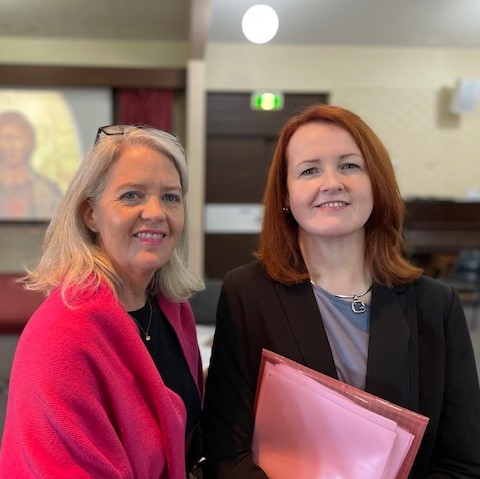
Bridget Hawthorne – Chris’s Executive Assistant with Meta Jackman – Director of Professional Standards and Safeguarding

Mark McGinnity – Director of MSC Education with Anne McAtomney - Chevalier Institute Director
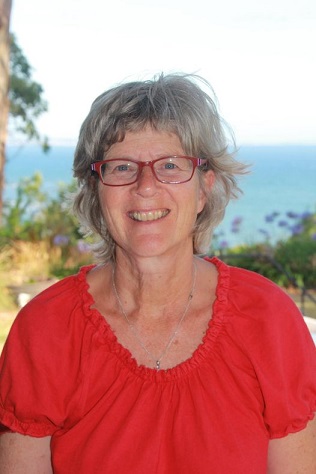
Clare Shearman – Director of Heart of Life, MSC Spirituality & Pastoral Formation

Joe Ensing with Catherine Molihan – Director of Province Care and Assisted Living

Fred Stubenrauch – Director of Australian Council of the Laity of the Chevalier Family; Alison McKenzie – Chair of the International Council of the Laity of the Chevalier Family.
Mommy Dead and Dearest
MOMMY DEAD AND DEAREST
US, 2017, 82 minutes, Colour.
Directed by Erin Lee Carr.
 This is a very strong documentary, a close-up on a murder, the perpetrator, the background. However, there is quite a change of tone as the audience follows the case, the victim, the murderer, extraordinary situations.
This is a very strong documentary, a close-up on a murder, the perpetrator, the background. However, there is quite a change of tone as the audience follows the case, the victim, the murderer, extraordinary situations.
This is the kind of documentary made by HBO and other documentary makers during the 2010s, close-ups of crime, interviews with perpetrators, with close witnesses, with journalists, with lawyers, prosecutors and offenders. This film was 18 months in the making, focusing on events within a year and more of the murder.
The audience initially sees the accused, Gypsy Rose Blanchard, a feeble looking young woman, younger than her age, seemingly unable to walk. And then she walks, to the surprise of many people, including her close friends and her father and stepmother.
The background of the story is teenagers marrying in Louisiana because the girl was pregnant. She then takes possession of her little child, seemingly precocious at first with footage of her at age 1, but then is emerging that she had quite a number of physical disabilities, from asthma and epilepsy to all kinds of ailments including paralysis from the waist down. She is Gypsy Rose Blanchard. Her mother is DeeDee Blanchard.
It emerges that the mother was perpetrating a fraud, getting all kinds of benefits, fruit of donations, visits to Disney World… Later opinions state that this is a case of Munchausen, a parent virtually imprisoning their child.
Gypsy went online and teamed up with the young man, Nick, and together they planned the stabbing of DeeDee. The young man did the stabbing, Gypsy in the next room, the two of them texting in preparation and afterwards. The film does not focus on the young man, shows him being interrogated, indicates multiple personality disorder, and was found guilty with a long sentence.
This film however, opens up the life of Gypsy, who proved to be quite intelligent, able to reflect on her life and her mother, especially during a lengthy interview with a sympathetic journalist. Quite an amount of time is given to her father and stepmother, interviews, in court, and the final sequence where they visit her in prison. There are also interviews with DeeDee’s father and stepmother, not very sympathetic towards their daughter. There is also a cousin who is very unsympathetic towards her.
What happens in this film is the audience understands better the strange situation, the influence of mother and daughter, strange characteristics of the mother over the years, the reaction of Gypsy (remembering that she was strongly medicated all the time), a plea made for second-degree murder and her sentence of 10 years which she accepts.
On reflection, it is surprising how Americans do this kind of documentary, interviewing the suspect, lawyers, the family.
Firestarter/ 2022
FIRESTARTER
US, 2022, 94 minutes, Colour.
Zac Efron, Ryan Kiera Armstrong, Sydney Lemmon, Michael Greyeyes, Gloria Reubin, Kurtwood Smith, John Beasley, Tina Jung.
Directed by Keith Thomas.
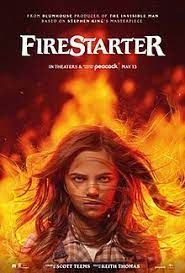 The first version of Stephen King’s Firestarter was released in 1984, starring a young Drew Barrymore, her next film after her success in ET. With its pyrotechnic themes and telepathy, it was linked with King’s Carrie. Now, almost 40 years later, umpteen by umpteen versions, cinema and television series, of Stephen King’s numerous tales, here is a new version of Firestarter.
The first version of Stephen King’s Firestarter was released in 1984, starring a young Drew Barrymore, her next film after her success in ET. With its pyrotechnic themes and telepathy, it was linked with King’s Carrie. Now, almost 40 years later, umpteen by umpteen versions, cinema and television series, of Stephen King’s numerous tales, here is a new version of Firestarter.
Reviews, comment and box office success of been rather negative. As might be expected, a lot of the criticism has been along the lines of “unnecessary remake”. However, while this might be important for devotees of adaptation of Stephen King’s stories, it may not be so relevant to ordinary cinemagoers, in the cinemas or watching streaming. They may not have read the novel. They may not remember the 1984 version. Which means that they would be coming to this version without presuppositions.
In fact, some comments have reminded audiences that the original novel is 500+ pages. Here we have a 94 minute film (including five minutes of final credits). Obviously, not all the novel has been incorporated into the screenplay. Rather, one might say this is something of a streamlined version, the core of the story and the characters fitting into a brief and brisk drama. The characters are the same as in the previous version, including the main names. However, the sinister Captain Hollister is now played by a woman, Gloria Reubin.
The screenplay is more straightforward in its narrative, allowing for some flashbacks. The setting is established, the little girl, Charlie (Ryan Kiera Armstrong who has already appeared in a Stephen King adaptation, It Chapter 2) has innate firestarting powers. Her parents, Zac Efron and Sydney Lemmon, also have powers but are protective of their daughter. However, the powers that be at the Institute wanted Charlie back for further study and experimentation. There is a glimpse of Dr Wanless who initiated the processes, played by veteran Kurtwood Smith, and a previous subject with psychopathic tendencies, Rainbow (Michael Grayeyes).
While some early scenes established family life, Charlie considered weird at school, a sympathetic teacher, her fire rage breaks out and the family have to go on the run. The main episode concerns an old man, Irv (John Beasley) picking up father and daughter and giving them some hospitality. However, Security is short lived and the police are called, Rainbow arrives leading to a massacre.
Then, quickly, her father is interned in the Institute, Charlie finds her way back and there is a confrontation, multiple fires, apocalyptic.
Not the most startling of Stephen King’s adaptations, but a brief story exploring and dramatising some of his themes.
- Popularity of Stephen King’s stories? The original Firestarter, 1984? Remake or adaptation?
- The brief running time, taking the core of the novel? How effective?
- The background, the Institute, Dr Wanless, aims and ambitions, Capt Hollister, the experiments, the effects, on Rainbow? On Charlie? The background of her parents and their powers?
- The scene of the parents with the baby, love for her, the balls, the fire, extinguishing it? The transition to Charlie aged nine? Home life, ordinary? At school, considered weird? Sport, throwing the ball, her being hit, containing her rage? Her teacher, sympathetic? The toilet sequence and the fire? The principal, the interviews with the parents?
- Andy and Vicky, the story of the meeting, marriage, Andy and his powers, as illustrated with the client who came to give up smoking, his intensity, his eyes, the blood? Success?
- Rainbow, his character, from the Institute, Hollister sending him out, his quest, the attacks, the violence? Interactions with Charlie? The continued pursuit, the police, at Irv’s house, the shootout, Charley escaping? Rainbow’s pursuit?
- The parents, the decision to escape, Rainbow and his attack on Vicky, her death?
- The escape, abandoning the car, being picked up by Irv, his hospitality, his wife and the accident, Charley communicating with her, stating the truth about the accident, forgiving her husband?
- The television news, and his reaction, Irv’s phoning the police, warding them off? Rainbow and the attack?
- The capture of Andy, in the cell, tied up?
- Charlie, going to seek her father, the three boys, the bike, infiltrating the establishment, the agent, the confrontation in the car, his death, the card, the entry, the security? The interaction with Hollister, the threat of fire and consuming her father? Andy, offering himself for her safety? Their being burnt?
- The escape, Rainbow, the encounter with Charlie the lake – offering his hand? The future?
Star Trek Insurrections
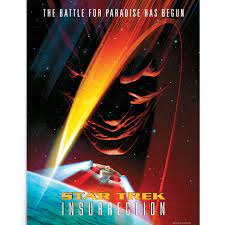
STAR TREK: INSURRECTION
US, 1998, 13 minutes, Colour.
Patrick Stewart, Jonathan Frakes, Brent Spiner, LeVar Burton, Michael Dorn, Gates McFadden, Marina Sirtis, F. Murray Abraham, Donna Murphy, Anthony Zerbe, Gregg Henry, Daniel Hugh Kelly.
Directed by Jonathan Frakes.
This is the third theatrical film in the series featuring Patrick Stewart as captain of the Enterprise. The regular cast are all present and Jonathan Frakes, William Riker, directs this film. It features Brent Spiner as Data with other members of the enterprise. The villain is F. Murray Abraham, hidden behind some grotesque make up, as is Gregg Henry as his associate. Anthony Zerbe has an ambiguous role as an admiral.
While there are the expected activities aboard the enterprise, the film opens with Data under suspicion, seeming to go rogue, threatening a peaceful Shangri-La type of community. However, he eventually comes under control and returns to his ordinary self, still puzzling about his humanity.
The Shangri-La setting is a planet where the atmosphere and the radiation prevent people from growing old. This community is more than 300 years old but seems a very ordinary, peaceful community, led by Daniel Hugh Kelly and Donna Murphy. Their commitment is not to take up arms. However, there is a group of guards with surveillance over them. A plot emerges that they are all to be transferred off the planet, given alternate accommodation, use for experimentation and then to be discarded.
Needless to say, Captain Picard goes to the rescue. He is charmed by the community, but especially by one of the women, Donna Murphy, unmarried, more adventuresome than the men, who explains matters to Picard – and the two are attracted. There is also a little boy who has been afraid Data but then befriends him.
There is also galactic activity is in all the films. The rebels, led by F. Murray Abraham are manipulating the admiral but ultimately destroy him. It then emerges that they were young rebels from the Shangri-La who went out on their own, aged, bent on revenge, wanting to take over the planet and destroy the inhabitants. Which leads to various kinds of attacks on the Shangri-La, Picard and his team leading the inhabitants to a refuge and safety despite the attacks, a special role for Data who is underestimated by the rebels and his being able to sabotage them. In the meantime, William Riker and the others are on a mission to inform the Federation about what is happening.
Which leads up to a climax, Picard and the rebel leader confronting each other and some peace restored to this part of the galaxies.
Interesting to see the romantic side of Picard. The others are all welcome characters – but, F. Murray Abraham with his strong reputation offers quite some interest is the vengeful leader.
Star Trek Nemesis

STAR TREK: NEMESIS
US, 2002, 116 minutes, Colour.
Patrick Stewart, Jonathan Frakes, Brent Spiner, LeVar Burton, Michael Dorn, Marina Sirtis, Gates McFadden, Tom Hardy, Ron Perlman, Dina Maier, Jude Cicolellat, Kate Mulgrew, Wil Wheaton, Whoopi Goldberg.
Directed by Stuart Baird.
This is the fourth of the feature films focusing on the career of Capt Jean-Luc Picard as captain of the enterprise, played iconically by Patrick Stewart over a period of 35 years. He appeared in a television series beginning in the late 1980s. And, he was to take up his role again in the 2020s. And a number of the supporting cast in these films had roles or cameo appearances in the later television series as well as in a great variety of video games.
This film presupposes the basics of its three predecessors, the crew of the Enterprise and their confrontations with various evil characters, played by Malcolm McDowell, F Murray Abraham. In this film, the villain is quite young, in the court of the Romulans (which resembles ancient Rome), a praetor who rebels against the authorities and destroys them all. He is supported by a team of rather monstrous-looking characters. The surprise, especially in retrospect, is that the villain is played by a very young Tom Hardy in his early 20s. In the years following, he played a number of significant roles, but then Bronson which led to his international career and international prominence.
The development in the series is another character, an android, similar looking to Data and played also by Brent Spiner. In fact, Data has undergone quite a transformation throughout these films, initially a subject for jokes about being human and feeling and the limitations of androids to his becoming essential to the management of the enterprise and also some heroics.
The villain is self-confident, hostile to earth and humans, but injecting himself with the blood of Picard, bond in which he understands Picard’s mentality – and vice versa. This leads to some confrontations, verbal, threatening, the challenge to Picard to confront this something of an alter ego. Picard has the complete support of his crew, even, at the end, to Data achieving heroics and giving his life for Picard. The rest of the team are their usual selves – except that at the beginning of the film there is a wedding ceremony in which William Riker marries Deanna. Honeymoon postponed and their both being involved in the attack, even a psychic/physical assault on Deanna.
Ultimately, there is a huge battle, and a smashing finale as the enterprise bores its way through the opposing vehicle, smithereens. And then, the confrontation between Picard and the villain.
In 2009, the next series of Star Trek movies began, with Chris Pine as James T.Kirk and Zachary Quinto as Spock, prequel films.
The end of an Era in the MSC Canadian Province
The end of an Era in the MSC Canadian Province
The changing membership of the Congregation as Provinces change. A merger.

On April 7th – 8th an important gathering took place in Québec. Some 13 members of the MSC province assembled to celebrate the provincial conference and chapter. All the members of the province were convened for this historical event. Why historical?
In his opening address, the provincial Fr. Marc-André Gingras made it clear that the main purpose of the conference was to come to terms with the project of a fusion with the province of Santo Domingo that was on the table since 2017. The chapter had to elect a new provincial as well.

For the merging of the two provinces, a workgroup had prepared a draft proposal that previously had been submitted to the members of both provinces and amended by them. The workgroup worked together with a canonist and a civil lawyer but unfortunately, the pandemic didn’t allow them to finalize it earlier and celebrate the chapter in 2020.
The proposal was now adopted by a large majority and the chapter decided to submit it to the General Superior so that all the Canadian confreres can become a community of the Dominican MSC province. This province will also discuss the agreement later this month during their provincial chapter. Their provincial Fr. Juan Tomảs Garcỉa Pichardo took part in our assembly.
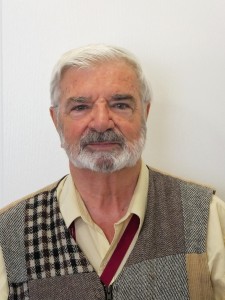
Fr. Gilles SAVARD, MSC – New Provincial of Candian Province
After the vote on the proposal for the fusion of both provinces, the chapter assembly proceeded with the election of a new provincial. On the first ballot Fr. Gilles SAVARD obtained the required majority of voices. Fr. Gilles was on leave for health reasons and booked already his return ticket to his mission in Mexico. We are all very grateful for his availability to be the new leader of this aging province. The average age of the 16 members of the province is 80 and they went through a process of “letting go” of ministries and properties. Today 12 of them are living in a nursing home together with the Sisters of St.Joseph of Bordeaux, the Brothers of St. Vincent, and a number of laypeople. When they closed the Sanctuary of Our Lady of the Sacred Heart here in Québec the Fathers of the Blessed Sacrament offered them hospitality but when they sold their (too) big property they found a new home in the facility of the Sisters.
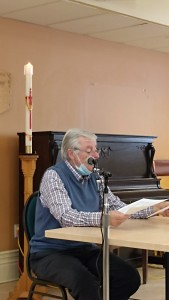
Fr. Marc-Andre Gingras, MSC
A whole-hearted “thank you” was given to Fr. Marc-André for his dedicated service to the province, altogether 20 years of his life.
We wish Fr. Gilles and the whole province to be happy in the emerging future because the mission goes on!
As a souvenir of this event the province published an interesting book La Province Canadienne des Missionnaires du Sacré-Cœur. Son histoire, ses artisans. Tome 2, 94 p. The first part of the book was published by Fr. Yvon Labbé in 1989. Congratulations !
(Andre Claessens)
Who’s at the Provincial Conference?
Who’s at the Provincial Conference?
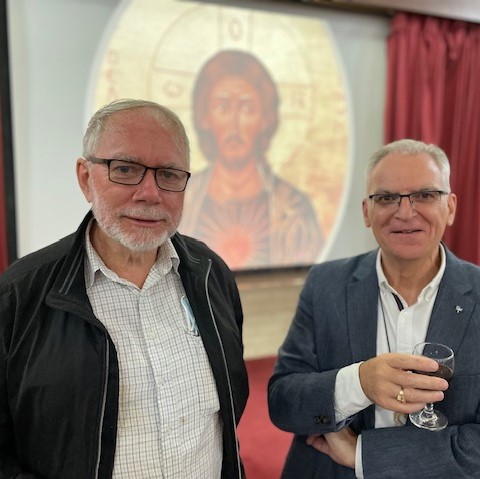
Leo Wearden, Chris McPhee

From overseas, Bern, Japan, Hoang, Vietnam, Joe Ensing, PNG
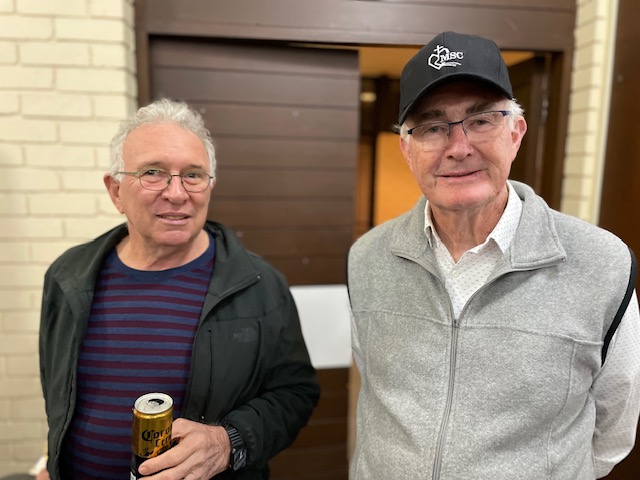
Peter Carroll, Frank Dineen,
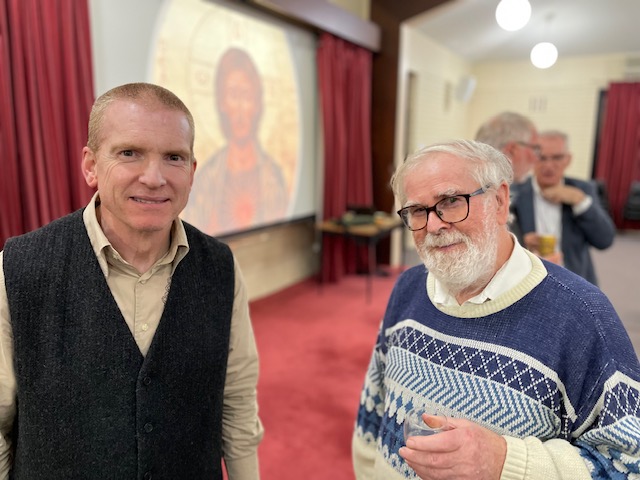
Dominic Gleeson, Philip Malone
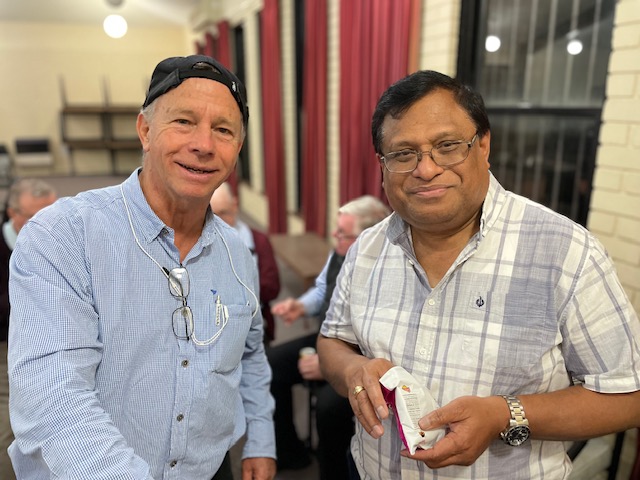
Mark Hanns, Alo Lamere
There should be some others – and Peter Hendriks is unseen taking the photos
Jim Littleton MSC continues his stories of some remarkable men: Sharing the Charism
Jim Littleton MSC continues his stories of some remarkable men: Sharing the Charism

Jim notes that this is the eighth booklet in the series on remarkable MSC.

– He writes on:
James Gilbert
Patrick McGuane
Gabriel Saap
Edward Bennett
John Bell
Tyson Donnelly
Alan Kinnane
Brian Strangman
and, more photos in this booklet than before.
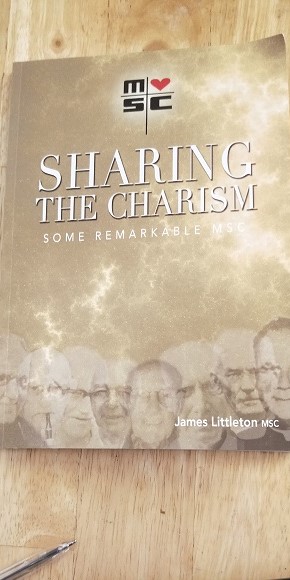
For inquiries about copies: JimLittleton272@g mail.com


